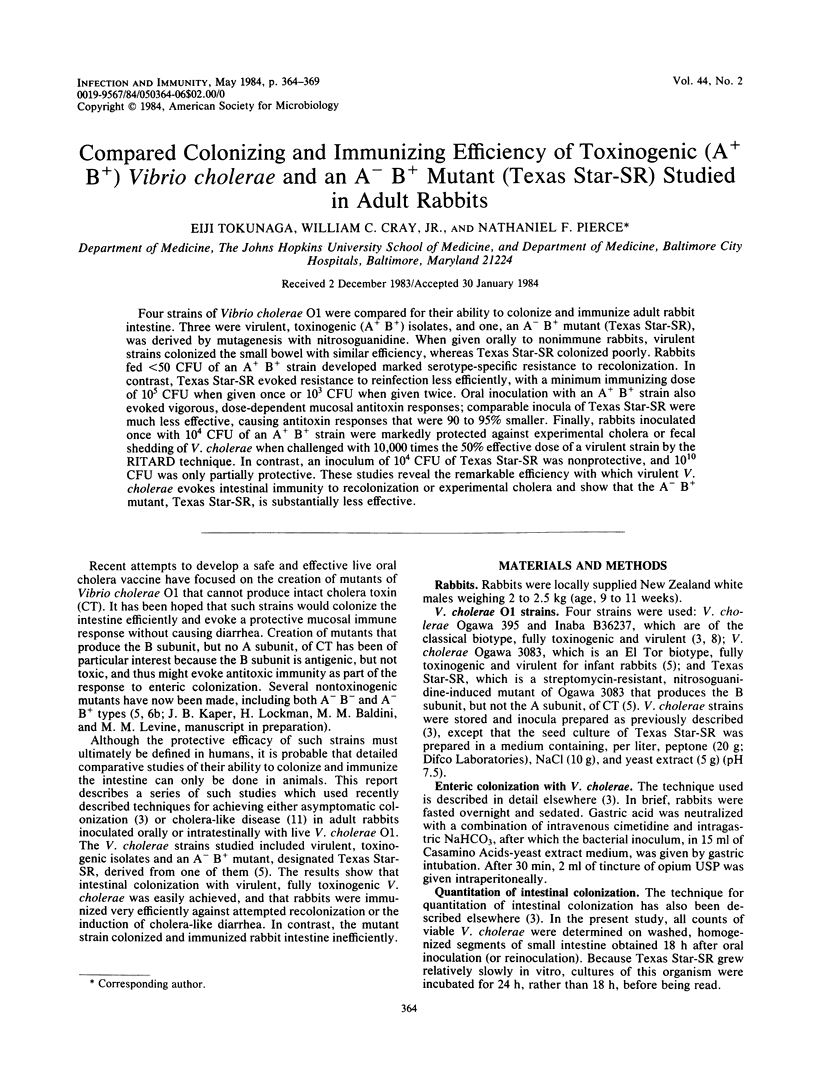Abstract
Four strains of Vibrio cholerae O1 were compared for their ability to colonize and immunize adult rabbit intestine. Three were virulent, toxinogenic (A+ B+) isolates, and one, an A- B+ mutant (Texas Star-SR), was derived by mutagenesis with nitrosoguanidine. When given orally to nonimmune rabbits, virulent strains colonized the small bowel with similar efficiency, whereas Texas Star-SR colonized poorly. Rabbits fed less than 50 CFU of an A+ B+ strain developed marked serotype-specific resistance to recolonization. In contrast, Texas Star-SR evoked resistance to reinfection less efficiently, with a minimum immunizing dose of 10(5) CFU when given once or 10(3) CFU when given twice. Oral inoculation with an A+ B+ strain also evoked vigorous, dose-dependent mucosal antitoxin responses; comparable inocula of Texas Star-SR were much less effective, causing antitoxin responses that were 90 to 95% smaller. Finally, rabbits inoculated once with 10(4) CFU of an A+ B+ strain were markedly protected against experimental cholera or fecal shedding of V. cholerae when challenged with 10,000 times the 50% effective dose of a virulent strain by the RITARD technique. In contrast, an inoculum of 10(4) CFU of Texas Star-SR was nonprotective, and 10(10) CFU was only partially protective. These studies reveal the remarkable efficiency with which virulent V. cholerae evokes intestinal immunity to recolonization or experimental cholera and show that the A- B+ mutant, Texas Star-SR, is substantially less effective.
Full text
PDF





Selected References
These references are in PubMed. This may not be the complete list of references from this article.
- Boesman-Finkelstein M., Finkelstein R. A. Protection in rabbits induced by the Texas Star-SR attenuated A-B+ mutant candidate live oral cholera vaccine. Infect Immun. 1982 Apr;36(1):221–226. doi: 10.1128/iai.36.1.221-226.1982. [DOI] [PMC free article] [PubMed] [Google Scholar]
- Cash R. A., Music S. I., Libonati J. P., Craig J. P., Pierce N. F., Hornick R. B. Response of man to infection with Vibrio cholerae. II. Protection from illness afforded by previous disease and vaccine. J Infect Dis. 1974 Oct;130(4):325–333. doi: 10.1093/infdis/130.4.325. [DOI] [PubMed] [Google Scholar]
- Cray W. C., Jr, Tokunaga E., Pierce N. F. Successful colonization and immunization of adult rabbits by oral inoculation with Vibrio cholerae O1. Infect Immun. 1983 Aug;41(2):735–741. doi: 10.1128/iai.41.2.735-741.1983. [DOI] [PMC free article] [PubMed] [Google Scholar]
- Holmgren J., Svennerholm A. M., Ouchterlony O., Anderson A., Walletström G., Westerberg-Berndtsson U. Antitoxic immunity in experimental cholera: protection, and serum and local antibody responses in rabbits after enteral and parenteral immunization. Infect Immun. 1975 Dec;12(6):1331–1340. doi: 10.1128/iai.12.6.1331-1340.1975. [DOI] [PMC free article] [PubMed] [Google Scholar]
- Honda T., Finkelstein R. A. Selection and characteristics of a Vibrio cholerae mutant lacking the A (ADP-ribosylating) portion of the cholera enterotoxin. Proc Natl Acad Sci U S A. 1979 Apr;76(4):2052–2056. doi: 10.1073/pnas.76.4.2052. [DOI] [PMC free article] [PubMed] [Google Scholar]
- Levine M. M., Black R. E., Clements M. L., Cisneros L., Nalin D. R., Young C. R. Duration of infection-derived immunity to cholera. J Infect Dis. 1981 Jun;143(6):818–820. doi: 10.1093/infdis/143.6.818. [DOI] [PubMed] [Google Scholar]
- Levine M. M., Black R. E., Clements M. L., Lanata C., Sears S., Honda T., Young C. R., Finkelstein R. A. Evaluation in humans of attenuated Vibrio cholerae El Tor Ogawa strain Texas Star-SR as a live oral vaccine. Infect Immun. 1984 Feb;43(2):515–522. doi: 10.1128/iai.43.2.515-522.1984. [DOI] [PMC free article] [PubMed] [Google Scholar]
- Mekalanos J. J., Swartz D. J., Pearson G. D., Harford N., Groyne F., de Wilde M. Cholera toxin genes: nucleotide sequence, deletion analysis and vaccine development. Nature. 1983 Dec 8;306(5943):551–557. doi: 10.1038/306551a0. [DOI] [PubMed] [Google Scholar]
- Pierce N. F., Cray W. C., Jr, Sacci J. B., Jr Oral immunization of dogs with purified cholera toxin, crude cholera toxin, or B subunit: evidence for synergistic protection by antitoxic and antibacterial mechanisms. Infect Immun. 1982 Aug;37(2):687–694. doi: 10.1128/iai.37.2.687-694.1982. [DOI] [PMC free article] [PubMed] [Google Scholar]
- Pierce N. F., Gowans J. L. Cellular kinetics of the intestinal immune response to cholera toxoid in rats. J Exp Med. 1975 Dec 1;142(6):1550–1563. doi: 10.1084/jem.142.6.1550. [DOI] [PMC free article] [PubMed] [Google Scholar]
- Pierce N. F. The role of antigen form and function in the primary and secondary intestinal immune responses to cholera toxin and toxoid in rats. J Exp Med. 1978 Jul 1;148(1):195–206. doi: 10.1084/jem.148.1.195. [DOI] [PMC free article] [PubMed] [Google Scholar]
- Sigel S. P., Finkelstein R. A., Parker C. D. Ability of an avirulent mutant of Vibrio cholerae to colonize in the infant mouse upper bowel. Infect Immun. 1981 May;32(2):474–479. doi: 10.1128/iai.32.2.474-479.1981. [DOI] [PMC free article] [PubMed] [Google Scholar]
- Spira W. M., Sack R. B., Froehlich J. L. Simple adult rabbit model for Vibrio cholerae and enterotoxigenic Escherichia coli diarrhea. Infect Immun. 1981 May;32(2):739–747. doi: 10.1128/iai.32.2.739-747.1981. [DOI] [PMC free article] [PubMed] [Google Scholar]


